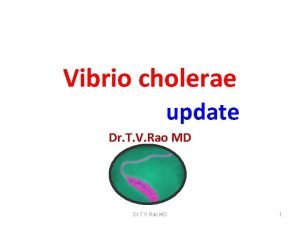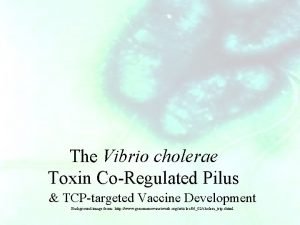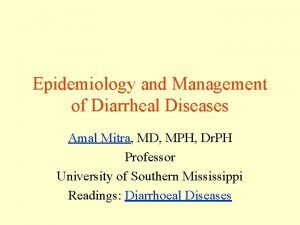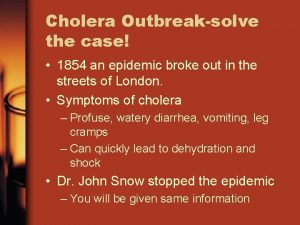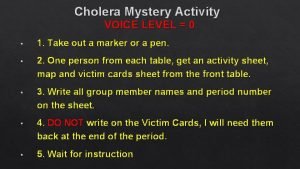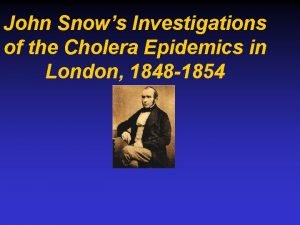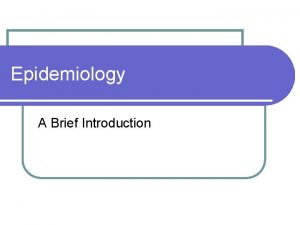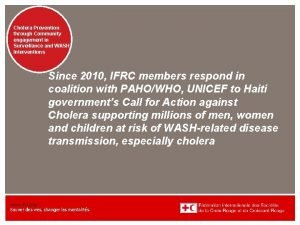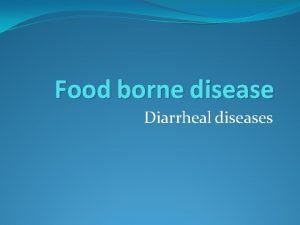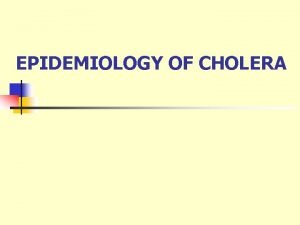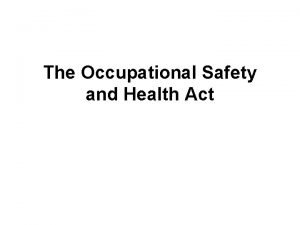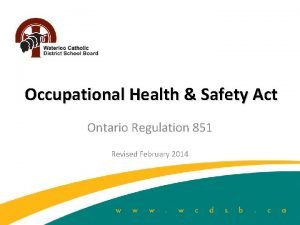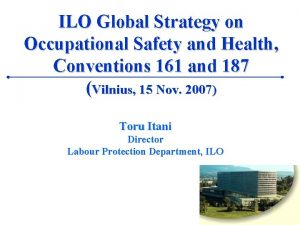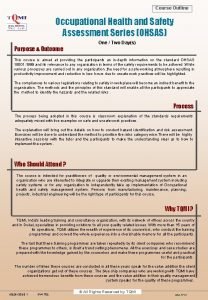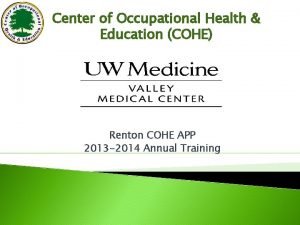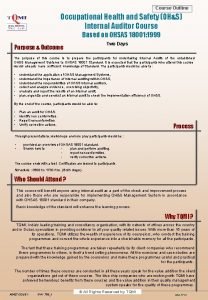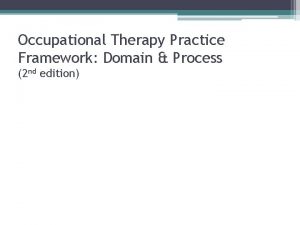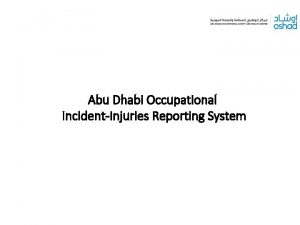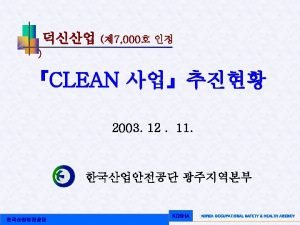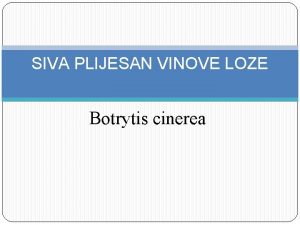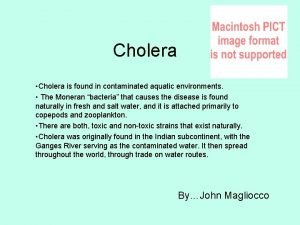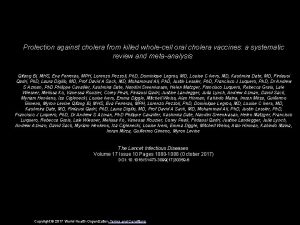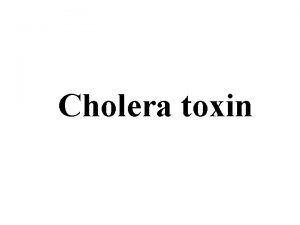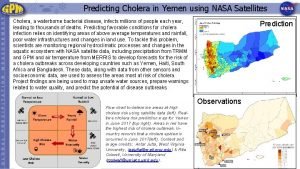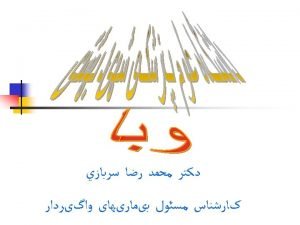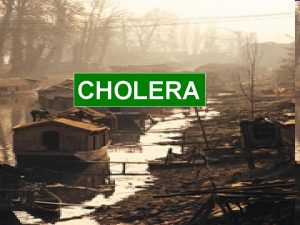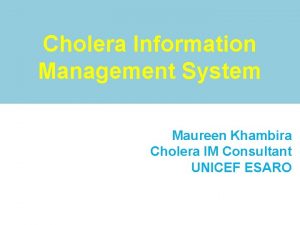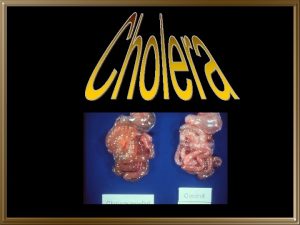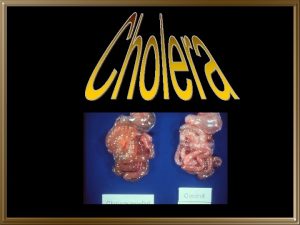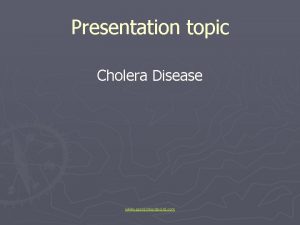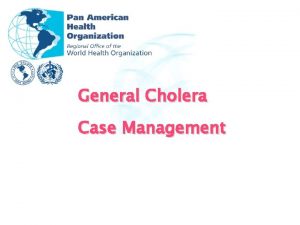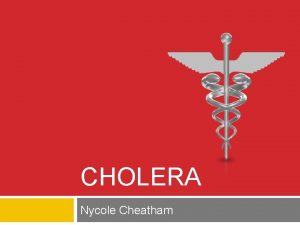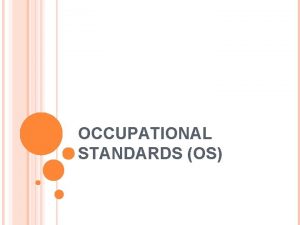Cholera An Overview Dr S Siva Occupational Health











































- Slides: 43

Cholera An Overview Dr. S. Siva Occupational Health Physician Aden Refinery Company Hospital Aden 1

Why this discussion today? ØUnprecedented surge of Cholera cases in Yemen ØOver 23, 400 suspected cholera cases Ø 242 deaths reported in 18 governorates ØIncreasing everyday Dr. Siva 2

What is Cholera? Cholera is an extremely virulent diarrheal disease that can kill within hours if left untreated. It is caused by the ‘comma’ shaped Cholera bacteria , Dr. Siva 3

How does it spread? By ingesting contaminated water or food (95%) By direct contact with a contaminated person (5%) Dr. Siva 4

In the large intestine: Bacteria multiply rapidly Toxin CTX from bacteria penetrates cells of intestinal wall Toxin prevents intestine from absorbing water from digested food thus resulting in severe diarrhoea The appearance of the stool is very specificpale and milky ‘RICE WATER STOOL’. This is due to the absence of bile pigments (which normally impart the color to the stool) Dr. Siva 5

Key Facts Most of those infected will have mild or no symptoms and can be successfully treated with Oral Rehydration Solution Severe cases will need rapid treatment with IV fluids and antibiotics Provision of safe water and sanitation is critical to control the transmission of cholera Oral cholera vaccine is an additional way of control but it should be used with other control measures Personal and environmental hygiene are very important to prevent cholera Take Dr. Siva Immediate action when a case is suspected

Multiply in the intestine and produce an exotoxin which causes diarrhea Most infected people are asymptomatic. Still they can excrete the bacteria in the environment, affecting other people, up to two weeks Cholera bacteria can be killed within minutes by boiling water Destroyed in acidity of p. H 5 or less. Children and old people who have less acid are at greater risk Survive in ice for 4 -5 days or longer Bleaching O powder can kill them instantly at 6 mg / ltr group people are more susceptible Infants derive temporary immunity from nursing mothers who had cholera Dr. Siva 7

Common Sources of Infection Drinking water: Water which is contaminated at its source (eg: by faeces through an incompletely sealed well) or during storage (eg: by contact with hands contaminated by faeces) Contaminated foods, stored unrefrigerated food eg: Milk, cooked rice, fasulia, foul, potatoes, fish, chicken and eggs especially in the present power cut situation. Although the original contamination may be slight, bacteria multiply to infectious levels during storage Dr. Siva 8

Ø Leafy vegetables: like sabana, girgir, karat etc. that have been freshened with contaminated water Ø Qat: when freshened or washed with contaminated water Ø Sea food: Particularly shellfish taken from contaminated water and eaten raw or insufficiently cooked Ø Direct Contact: Person to person by contaminated fingers Dr. Siva 9

Who is most at risk? Those living near coastal waters, low lying areas with brackish water, fishing villages, slums & refugee camps with unsafe water sources Poor faecal disposal practices Bad personal hygiene and food hygiene People close to cholera patients in early stages (hyper-infectivity) and unsafe handling of infected dead bodies Dr. Siva 10

When does cholera become epidemic? After heavy period of rainfall Hot climate when water temperatures rise When normal diarrhoeal incidence increases Endemic cholera becomes epidemic when sanitary condition is poor Dr. Siva 11

Well water can also be a reservoir of cholera bacteria in villages Dr. Siva 12

How long does it take to manifest? Incubation period - 2 hrs to 5 days (depends on the number of bacteria and the immunity of the person) Most infected people do not become ill or show any symptoms. Yet they shed bacteria in stool upto 2 weeks Only about 10 -20% of infected people show moderate or severe symptoms Moderate symptoms are difficult to differentiate from other types of acute diarrhoea Dr. Siva 13

Clinical Features Sudden onset of profuse, effortless, watery diarrhea (‘Rice water stool’). 1 liter an hour Nausea & Watery Vomiting in early stages Rapid dehydration within hours. Loss of 10% body weight or more Electrolyte loss leading to muscle cramps and shock Suppression If of urine no treatment, 30 - 40% die In children, altered state of consciousness, seizures and coma Dr. Siva 14

Cholera bacteria invading intestine Dr. Siva Toxin CTX binds to the intestinal walls and interferes with normal flow of Na & K. This causes body to secrete large amount of water 15 and hence diarrhea

Rice Water Stool Dr. Siva 16

Infectious Dose • Dose related. Infectious dose ranges from • 106 1011 colonizing units • High level of bacteria is necessary so as to escape the gastric acid barrier • Convalescent carriers are infective for 2 -3 weeks (those who did not receive antibiotics) • Heathy carrier: Subclinical infection through contact with source of infection • Chronic carrier: Rare. Here the bacteria stay in the gall bladder and get excreted upto 10 years Dr. Siva 17

Stages of illness: ØStage of Evacuation: Abrupt, profuse watery diarrhoea, vomiting. May be 40 times per day ØStage of collapse: Signs of acute dehydration ØStage of Recovery: With treatment patient begins to improve Dr. Siva 18

Look for ‘Visible Symptoms’ • These include: • Sunken eyes and cheeks • Decreased skin suppleness • Dry mucous membranes • Urine production falls sharply • Decreased or stopped altogether • Renal failure is the most common • Complication seen in recent outbreaks Dr. Siva 19

Dehydration- Mild and Severe Ø 1. Appearance Thirsty, alert, restless Drowsy, limp, cold, sweaty, may be coma Ø 2. Radial Pulse Normal Rapid, Feeble, sometimes impalpable Ø 3. BP Normal <80 or un-recordable Ø 4. Skin elasticity Pinch retracts slowly Ø 5. Tongue Moist Very dry Ø Ant. Fontanelle Normal Sunken Ø Urine Normal Little or none Ø Body weight loss 4 -5% Dr. Siva Ø Fluid deficit 40 -50 ml/kg 10% or more 100 -110 ml/kg 20

Severe Disease (Cholera Gravis) A healthy and active person becomes ill and unconscious in a few hours • Patients present after a few hours with massive volume loss • 500 – 1000 ml per hour, can rapidly lose more than 10% of their body weight • Mortality due to circulatory collapse from dehydration and electrolyte loss Dr. Siva 21

Cholera Gravis Severest form of cholera Infection Patients in 2% of infected individuals with blood type O most susceptible Characterized by voluminous expulsion of electrolyte-rich fluid in patient’s stool Amounts Responds In Dr. Siva greater or equal to patients blood volume well to rehydration therapies areas where not available, death rates are astronomical 22

Complications: Severe Disease • Complications result from massive fluid and electrolyte loss as the Cholera stool contains high concentrations of sodium, potassium, chloride, and bicarbonate • Therefore in addition to volume depletion, which can cause renal failure, additional complications can occur: • Hypokalemia: causes arrhythmias, ileus, leg cramps • Metabolic Acidosis: due to phosphate moving out of cells • Hypoglycemia: mental status changes and seizures • Hypotension: due to water loss • Hypofusion of critical organs Dr. Siva 23

Mortality • In untreated patients, mortality can reach 50 -70% • Risk much higher in children • 10 x greater than adults • As well as pregnant women • 50% risk of fetal death in 3 rd trimester • Patients can die within 2 -3 hours of first sign of illness also seen from 10 hours- several days Dr. Siva 24

Ask questions Ask for recent trips to endemic areas in Yemen and abroad • Ask questions in detail about recent food (hotels, marriages, parties)- cool drinks, cool water, hakkein undercooked or raw shellfish and other sea foods from certain locations, food from refrigerator. • Collect stools, rectal swab, vomitus, water and food samples • 25

Differential Diagnosis Cholera should be considered in all cases with severe watery diarrhea and vomiting However, there are no clinical manifestations that can distinguish cholera from other infectious causes of severe diarrhea like: Enterotoxigenic Bacterial Viral Dr. Siva e. Coli food poisoning gastroenteritis 26

Laboratory Diagnosis Vibrios often detected by dark field or phase contrast microscopy of stool. Comma shaped motile organisms, appearing like “shooting stars” Culture: yellow colonies appear confirming cholera present Additional methods of detection include PCR and monoclonal antibody-based stool tests Rapid Dr. Siva cholera dipstick tests 27

Rehydrate before dehydration Dr. Siva 28

Treatment § The course of treatment is decided by the degree of dehydration § Start treatment before the cause of infection is identified. If not, death can occur within hours § Three options prove most effective: v Oral Rehydration v Intravenous Rehydration v Antimicrobial Dr. Siva Therapy 29

Treatment: Rehydration Therapy Oral Rehydration: Packets of ORS-Bicarbonate & ORS-Citrate are commercially available. To be dissolved in water and given, in cases of mild-moderate diarrhea (1 packet per liter of water) Amount depends on patient’s desire to drink and signs of dehydration Mothers should be taught how to administer: <2 yrs 1 tsf every 1 -2 mts. If vomits, wait for 10 mts and try again. If child is breast fed, nursing can be continued Non breast fed infants under 6 months should be given an additional 100 -200 ml clean water during first four hours IV rehydration in severe dehydration: (RL, Saline, DTS 100 ml/kg) till diarrhea stops and then continue ORS for two days. Dr. Siva. Initial rehydration till palpable pulse, then slow down. Look for skin elasticity 30

Oral Rehydration q Oral Rehydration Solutions (ORS) have reduced mortality from cholera from over 50% to less than 1% q The World Health Organization recommends a solution containing: § 3. 5 g sodium chloride § 2. 9 g trisodium citrate and § sodium bicarbonate § 1. 5 g potassium chloride § 20 g glucose or 40 g sucrose Commercially sold over-the-counter as ‘Rehydralyte Dr. Siva 31

Intravenous Rehydration § Used in patients who lose more than 10% of body weight from dehydration or are unable to drink due to vomiting § Ringer’s Lactate used commercially in hospitals with appropriate electrolyte concentrations specified to patients needs Dr. Siva 32

Dosage – Antibiotic Agents Ø Ø Ø Given orally when vomiting stops. Tetracycline is the standard treatment. Fluoroquinolones are now an effective alternative in tetracycline resistance Administered in single dose primarily to prevent spread of secondary infection Zinc supplements: decrease duration of diarrhea Prophylaxis if one household member in a family becomes ill (WHO) WHO guidelines 33

Prevention and control • • Surveillance Water sanitation Hygiene Social mobilization Treatment Oral cholera vaccines Health education Dr. Siva 34

Oral Cholera Vaccines (OCV): • Oral cholera vaccines: • Dukoral: 2 doses. Provides 65% protection for 2 years • Shanchol and Euvichol: 2 doses provide 65% protection for five years The live vaccine is not preferred because of side effects and less protection Dr. Siva 35

Risky cultural practices / beliefs The following beliefs about causes of cholera may reduce effectiveness of key messages: Witchcraft, eye, wind, climatic change cause the sickness Children’s stools are not dangerous Soap is believed to wash away luck The following practices increase risks: Anal washing is often not followed by hand-washing Handshaking transfers bacteria directly from one person to the next Burial ceremonies may spread disease Dr. Siva 36

Health Education ØWith proper treatment, cholera is not fatal ØMost cases can be treated with simple measures ØHuman excreta to be disposed off safely ØClean water for drinking and bathing ØBreast feeding to be promoted ØFuneral practices for infected individuals Dr. Siva 37

Food Safety Ø Cooking food until it is thoroughly hot Ø Eating cooked food while it is hot Ø Washing and thoroughly drying all cooking and serving utensils after use Ø Safe handling of food Ø Washing hands thoroughly with soap and clean water Ø Avoid buying foodstuff like pickles, cheese when they are kept next to meat in supermarkets and Malls Ø Keeping eating place and kitchen clean. Presence of houseflies indicate poor hygiene Dr. Siva 38

Filtering water is the first step to health Dr. Siva 39

Pure water is the essence of health Dr. Siva 40

Soap and water go a long way Dr. Siva 41

Clean Toilets keep bacteria away Dr. Siva 42

Thank you! Dr. Siva 43
 Role of occupational health nurse
Role of occupational health nurse Selective media for vibrio cholerae
Selective media for vibrio cholerae Toxin coregulated pilus
Toxin coregulated pilus Types of cholera
Types of cholera Cholera toxin
Cholera toxin Cholera
Cholera Voice level 0
Voice level 0 Cholera outbreak malaysia
Cholera outbreak malaysia Cholera
Cholera Cholera
Cholera Epidemiology concept
Epidemiology concept Cholera
Cholera Cholera
Cholera Plan b of dehydration management
Plan b of dehydration management Cholera is a greek word that means gutter of roof
Cholera is a greek word that means gutter of roof Yaş sıva üzerine boyalarla yapılan renkli
Yaş sıva üzerine boyalarla yapılan renkli Indus river valley art
Indus river valley art Siva ekonomija u srbiji
Siva ekonomija u srbiji Jedra kranijalnih nerava
Jedra kranijalnih nerava Siva srinivasan
Siva srinivasan Sveta knjiga hinduizma
Sveta knjiga hinduizma Siva ekonomija definicija
Siva ekonomija definicija Satellite propulsion system
Satellite propulsion system History of osha
History of osha Chcp occupational health
Chcp occupational health Occupational safety and health act 1984
Occupational safety and health act 1984 Occupational health and safety presentation
Occupational health and safety presentation Ontario regulation 851
Ontario regulation 851 Define occupational health nursing
Define occupational health nursing Ipac competencies
Ipac competencies Global strategy on occupational safety and health
Global strategy on occupational safety and health Occupational health and safety course outline
Occupational health and safety course outline Confluence health occupational medicine
Confluence health occupational medicine Renton occupational health
Renton occupational health Aims and objectives of occupational health
Aims and objectives of occupational health Ohc stanford
Ohc stanford Occupational health and safety course outline
Occupational health and safety course outline Occupational therapy practice framework domain and process
Occupational therapy practice framework domain and process Occupational safety and health
Occupational safety and health Meded coventry
Meded coventry Abu dhabi occupational health
Abu dhabi occupational health Aota occupational profile template
Aota occupational profile template Korea occupational safety
Korea occupational safety Occupational safety and health
Occupational safety and health

